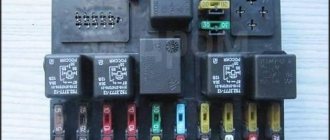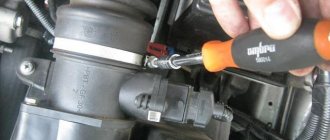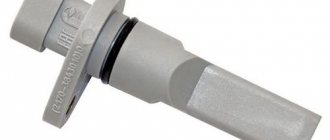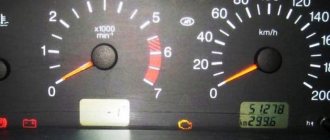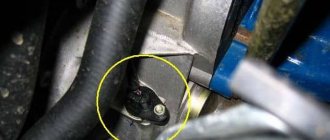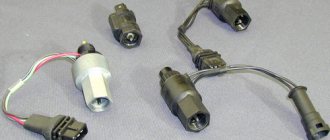A speed sensor (DS) is structurally provided on every car. It is designed to determine the speed of movement of the car and transmit the received data to the dashboard, or rather to the speedometer.
It is prohibited to operate a vehicle with a faulty speedometer, as this can lead to an accident or fines from the traffic police.
If the product breaks down, checking it does not take much time, and to complete the work you only need a multimeter or test lamp.
What is the device? What does it look like and where is it located? What are the signs of malfunctions, and how to check the speed sensor? These and other questions will be addressed in this article.
First, we will look at the main testing methods, and then we will touch on individual models: Lada Kalina, Priore, Granta, Gazelle, Nissan, Niva, VAZ 2110, VAZ 21093 injector.
Purpose and location
As we noted above, the sensor determines the speed of the vehicle and transmits the received data to the speedometer, where they are reflected. Speedometers are either pointer or liquid crystal.
The shaft is the main element of the product. It rotates and passes near a special mark once per circle. At this moment, a pulse is sent to determine the number of revolutions per minute.
The number of signals depends on the rotation speed of the shaft, the value of which is coordinated with the transmission shafts and wheel diameter. Thanks to this, information from the speed sensor is converted and sent to the speedometer.
The DS consists of three elements - the speedometer drive, the casing and the controller, through which the product is connected to the vehicle's electrical network. Depending on the make and model of the car, the appearance and design may vary.
The location of the speed sensor is also different. Before checking it, you need to find the device.
Common mounting locations are the transmission output shaft or transfer case (for all-wheel drive vehicles).
Older models used a cable that was screwed onto the speedometer drive. Today its place is taken by a speed sensor, connected using ordinary wires.
Selecting a new sensor
Replacing a new sensor is not particularly difficult, but it is important to choose the model that is compatible with your vehicle. For example, sensors can have different lengths depending on the type of gearbox in the car. For this reason, you can be guided by one of the following:
- VIN code;
- Vehicle data: model, year of manufacture, engine and gearbox type;
- The code of the suitable device.
In modern online stores, you can search both by codes and by car data. Often the search algorithm looks like this: enter car data, get a code, continue searching in other places. We advise motorists to save the codes of suitable devices and their analogues.
An electronic model of the device can be installed in a car with a mechanical sensor . To do this, it is enough to determine the model and year of manufacture of the transport device and transfer this information to a specialist. Next, he will select and install a suitable sensor, socket blocks, cables and tachograph. It is worth noting that sometimes to install a more modern sensor you need to use a special adapter.
When is a check needed?
Checking the DS is necessary for the following symptoms:
- unstable engine operation at idle;
- the speed of the machine is shown incorrectly;
- in normal operation, the car consumes more fuel;
- the speedometer does not show information (in case of complete failure);
- deterioration in acceleration dynamics;
- error information appears on the central display.
These signs may indicate other failures, for example, those related to the fuel or air systems.
Therefore, before making a final “verdict”, the speed sensor must be checked, and if the malfunction is confirmed, it must be replaced.
Excursion to the manufacturers
The variety of automotive electronics contributes to the emergence of a large number of packaging companies on the auto parts market. They sell sensors from large and small manufacturers under their own brand names. As practice shows, packers prefer to sell inexpensive, low-quality products in countries where the purchasing power of vehicle owners is low. For example, ]JP Group[/anchor], ERA and SWAG offer inexpensive speed sensors, the quality of which is not always satisfactory. We recommend paying attention to more expensive options from the following companies:
- Valeo;
- Pierburg;
- Behr-Hella.
These are the most famous manufacturers, whose sensors are included in the original equipment of the vast majority of cars. In fact, a car enthusiast can buy an almost complete copy of the original, but at a lower price. When choosing a sensor, it is especially important to be guided by which company manufactured it. Here it is worth paying attention first of all to well-known European, Korean, Japanese and American manufacturers. T.N. First-tier packers may also pleasantly surprise you, but there are not so many similar packers on the market - their names will be easy to remember.
Operating principle of the speed sensor
The operation of the speed sensor is based on the Hall effect. Pulses from the device are sent to the car's ECU, where they are converted into the necessary readings. It is known that 6000 pulses are transmitted per kilometer. The faster the signals arrive at the ECU, the higher the movement speed.
The electronic control unit receives impulses, processes them and provides information to the speedometer in a form understandable to humans. To determine the speed, a special algorithm is installed in the ECU.
As noted, the operation of the speed sensor is based on the Hall effect - a physical phenomenon that implies the appearance of voltage when a conductor is placed in a magnetic field.
While driving, rectangular or wave-shaped signals with a voltage of 1 to 5 Volts appear at the output of the product.
The use of a special scheme and program allows you to calculate the current speed of the car and other important parameters - average daily mileage, total distance traveled and other data.
For the advanced, below is a schematic diagram of how a car speed sensor works.
The speedometer sensor does not work: reasons
DSA malfunctions are usually caused by open circuits, damaged or oxidized contacts.
Structurally, the car speed sensor itself is quite reliable (considering the speed sensor, the device circuit is quite simple).
It is also important to consider the fact where the speed sensor is located. The location in the engine compartment at the gearbox does not prevent oil contamination, ingress of technical fluids, water and dirt, etc.
- At the initial stage, it is necessary to check the wiring and contacts for integrity. As for the contacts, it is necessary to clean and lubricate them (Litol type lubricant is suitable);
- The wires to the speed sensor usually break near the plug at the bend, as the wiring frays and the insulation cracks;
- At the same time, it is recommended to check the resistance in the grounding circuit. The norm is 1 Ohm.
If no wiring or contact defects are found or the methods discussed above do not resolve the problem, you need to check the speed sensor for functionality.
Signs and causes of malfunction
Symptoms indicating the need to check the speed sensor have already been indicated above. The main signs of a malfunction are the absence of readings on the speedometer, increased “gluttony” of the engine, malfunction of the engine at idle, deterioration in dynamics, etc.
A breakdown of the sensor may be indicated by engine stopping while driving, failure of the electric power steering wheel, or increased sensitivity of the FLS (for example, for Lada Kalina).
Common causes of sensor failure:
- violation of the integrity of contacts;
- oxidation at joints;
- open circuit;
- insulation melting;
- wear of the speedometer cable, etc.;
- strong vibration of the device;
- dirt ingress;
- temperature changes;
- Other reasons.
If you ignore problems, engine malfunctions occur and wear on its elements increases.
As a rule, the cause of problems is dirty contacts, which should be cleaned and treated with Lithol.
If there is a break in the electrical circuit, the damage should be looked for near the connection connector. This is where the wires are most susceptible to bending and breaking. Sometimes the insulation becomes damaged where the exhaust manifold is mounted.
When exposed to high temperatures, the insulation can be damaged, which leads to short-circuiting of the wires.
With prolonged use, the speedometer cable wears out, which eventually develops cracks and breaks, which leads to failure of the controller.
An equally common cause of speed sensor failure is a broken circuit, so before replacing the device you need to make sure it is working properly.
To begin with, you should discard the power supply and examine the contacts from the point of view of contamination. After cleaning, the surface is treated with Litol lubricant.
During the test, measure the resistance in the grounding circuit; it should be equal to one Ohm.
When analyzing a fault, consider the following:
- If the controller is working properly and the gear is intact, it is possible that the device is not receiving power or there is a short circuit in the network.
- The readings on the dashboard involve the ECU and ABS, so you need to check the integrity of the wire running from the speedometer to the unit. It happens that the dashboard itself fails.
- On cable-driven machines, the cause of the malfunction is often hidden in old oil on the gear or a worn square at the end of the cable.
Before replacing the sensor, make sure what is causing the problem. The algorithm of actions is as follows:
- take the cable out of the box, twist it and look at the speedometer’s reaction;
- check the electrical part of the speed indicator;
- if there is no voltage, you need to make sure the fuses are intact;
- remove the speed sensor, install the cable in the KPI and drive a short distance (if there is no data on the speedometer, we can talk about a breakdown of the DS).
Finding out the cause of the malfunction requires an integrated approach, as does checking the sensor (discussed below).
Also read about signs of a malfunctioning mass air flow sensor.
How can you check the functionality?
The main cause of a motion sensor malfunction is a violation of the integrity of the wires or contacts in the common circuit. To check the correctness of its operation, it is necessary to carry out several manipulations.
Let's assume you own a Lada Kalina car. Domestic cars produced by the AvtoVAZ concern are equipped with a speed sensor that operates on the Hall principle. It has several types of contacts: a voltage transmitter, one responsible for transmitting a pulse signal, and a contact that controls grounding.
To carry out verification, you need to choose the method that suits you most. It depends on the availability of the tool.
Examination
VAZ cars and a number of other cars have a speed sensor that operates on the Hall effect. It produces six pulses per revolution. But there are other devices - inductive or reed type.
The standard version of the controller operating on the Hall effect deserves the most attention.
The device has three contacts - pulse, ground and voltage. At the same time, car owners have three verification methods at their disposal.
First option:
- Removing the speed sensor from the car.
- Move the multimeter to the voltage change position (Volts).
- Determining the purpose of the contacts (pinout).
- Search for the pin that receives the pulse signal.
- Connect the “plus” of the multimeter to this terminal. “Minus” is connected to the ground terminal (you can use the car body).
- Rotate the shaft and monitor the voltmeter readings. The higher the cranking speed, the higher the voltage level.
To simplify the rotation process, a small piece of tube (for example, vinyl insulation) is put on the speed sensor axis.
The second method (suitable for Hall effect sensors) without removal:
- Check that the controller is connected.
- Lifting one wheel of the car. The goal is to lift it off the surface for easy rotation.
- Preparing the multimeter - switching the scale to measure voltage.
- Connecting the probes to the contacts in the same way as described above.
- Rotation of a wheel disconnected from the surface and evaluation of the results obtained.
The voltage level and frequency must change. This indicates that the speed sensor is working properly. If the readings remain unchanged, the device has failed.
The third method is with a control lamp:
- Preparing the warning lamp and turning on the ignition.
- Raising the car wheel for further rotation.
- Connecting one wire to the battery positive, and the second to the signal contact of the DC;
- Spin the wheel and watch the light bulb.
If the lamp blinks noticeably when the wheel rotates, this indicates that the speed sensor is working properly.
The fourth method is with a warning lamp and removing the speed sensor:
- Remove the controller from its original location.
- Build the circuit shown below.
- Connect the wires to the pins according to the pinout below.
- We connect one terminal to ground, the second to the battery positive. The latter can be not only for a car - you can use any 12 V power source.
- Take a piece of brake pipe and place it on the sensor rod. To make it easier to control the number of revolutions, screw electrical tape onto the tube, as shown below.
- Start rotating the rod using the tube. As a rule, the light should blink 6 times in one revolution, but it all depends on the make of the car.
Self-test
Every car owner should know how to check the speed sensor. There are three possible ways to determine if it is working properly. Before starting diagnostics, you should determine whether the sensor produces 12 V, since the basic principle of operation of the internal combustion engine is based on the Hall effect, the state of the contacts occurs exclusively during rotation.
The voltage readings of the sensor in operating condition should be in the range of 0.5-10 V.1. Check with a voltmeter. The DSA needs to be removed and it will be determined what each terminal is responsible for. One contact of the voltmeter should be connected to the terminal that outputs pulse signals, and the second should be connected to the ground wire.
The sensor must be rotated and at this time look at the voltage readings. The more intense the sensor rotates, the greater the readings will be.2. It is necessary to disconnect the impulse wire, which is detected by a special controller, and lift the wheel to rotate with a jack so that it does not touch the ground.
Connect the “Signal” control wire; if the indicator is “-“, then the speed sensor is working. A wire with a light bulb can replace the control in this method.3. To determine the operation of the sensor, it is not necessary to remove it from the car; to do this, you can lift it, as in the previous method.
Automatic transmission check
In cars with automatic transmission, it is better to trust the professionals. The reason is that such cars have many electronic components that are closely interconnected with each other (directly or through the ECU).
An attempt to independently check the speed sensor can lead to even greater damage and breakdown of the automatic transmission system.
There are many cases where attempts at self-checking ended in expensive repairs or the need to sell the car.
Repair or replacement?
Unfortunately, purchasing a new speed sensor can cost a significant amount of money. In some cases, you can repair it yourself. To do this, you need to remove the product and determine what is faulty.
- If any parts are broken, seal them with sealant.
- If there are serious contaminants, simply remove them - in some cases this is enough.
- A common cause of failure is erasing the bottom tracks on the vertical board. Resolder them. If you do not have much soldering experience, it is better to contact a specialist, since one awkward movement can lead to severe damage to the DC.
Checking the performance of the speed sensor is a simple matter that does not require specific skills. Don't forget about maintenance and this part of your car will last you a long time.
- Author: Dmitry Buimistrov
Hello! My name is Dmitry, I am a journalist by training. I specialize in automotive topics - I started my career in an online store of automotive components, and I myself am a car enthusiast. Rate this article:
- 5
- 4
- 3
- 2
- 1
(0 votes, average: 0 out of 5)
Share with your friends!
Checking the drive
Sometimes you only need to check the DC drive. Algorithm of actions:
- Raising one wheel using a jack.
- Search for the speed sensor drive (it is easy to find, thanks to its “sticking out” from the gearbox).
- Rotate the wheel with your free foot.
It is easy to determine by tactile sensations whether the drive is working or not. If the device does not function, it is worth disassembling it and assessing the condition of the teeth on the gears. If you lack experience, it is better to entrust the work to a specialist.
How to check DS?
First, we check for the presence of grounding and 12 V voltage in the contacts. Such contacts are checked by dialing. And the contact of the pulse signals is checked during torsion.
The voltage between the output and the ground of the working speed sensor ranges from 0.5 V to 10 V.
There are several ways to check your car's speed sensor:
- No. 1 Using a voltmeter.
- No. 2 Without removing the sensor from the car.
- No. 3 Using a light bulb or control.
Checking with a voltmeter:
- Remove the sensor.
- Connect one contact to the pulse signal terminal. We connect the second contact to the ground of the car.
- Next, we turn the speed sensor and see if signals are sent when the cycle is running and measure the output voltage of the DC. To rotate the sensor axis with your own hands, you need to put a tube on the sensor axis and twist it at a speed of up to 5 km/h. The faster you rotate the sensor axis, the more voltage the voltmeter will show.
Checking induction DC and with reed switch
Note that speed controllers differ in the signal coming from the wheels. Taking this fact into account, the DS check is also built:
- WITH REED SWITCH. The signals are rectangular in shape. The cycle is from 40 to 60 percent. Switching occurs at a voltage from 0 to 5 Volts or when the battery voltage is reached.
- INDUCTION. With these speed sensors, the signal is in the form of waves, so the voltage changes based on the speed at which the wheel spins. This can be seen on the oscilloscope. Otherwise the principle is identical to what happens on the crankshaft angle controller.
Design and principle of operation
The DS device is based on the Hall effect; the device transmits pulse-frequency signals to the ECU at certain intervals.
So, over one kilometer of travel, this device transmits about 6,000 signals and, based on the data received, the control unit automatically calculates the speed of the vehicle. The higher the speed of the car, the more intense the pulses arrive at the controller. In addition to determining speed, this device performs another important function. When the car is coasting, the pulse sensor does not block the flow of fuel, thereby contributing to savings. The principle of operation of the DS is quite simple, but if any malfunctions occur, this affects the operation of the power unit. Today it is customary to distinguish several types of DSAs, differing in design: inductive, reed and based on the Hall effect (electronic sensors).
Replacement instructions
If the malfunction is confirmed and the sensor needs to be replaced, the work is done according to the following algorithm:
- Turn off the ignition, open the hood and remove the terminal from the battery.
- Search for speed sensor. It can be located in different places, it all depends on the car model. This information can be found in the service book.
- Cleaning from contaminants. This is necessary to avoid foreign elements getting into the transmission.
- Removing the power connector and unscrewing the device. If you cannot disconnect the controller, you should treat the connection location with WD-40. It is not recommended to apply excessive force, as this may lead to damage to the integrity of the case. After applying the specified liquid, you need to wait some time.
- Removing the old and installing a new sensor, connecting wires.
- Resetting errors on the ECU (for models that have an electronic unit). If this work is not done, the light on the dashboard will light up, and the ECU will send signals about a breakdown.
Installing a new sensor
Given the fairly large number of sensors of various types, dismantling and installation may vary slightly depending on the model and year of manufacture of the car. In some cases, the devices have a cable drive, as a result of which the cable also needs to be disconnected, while in others the device looks very simple: a smooth plastic body with a hole for a fastening element . In general terms, replacing a speed sensor looks like this:
- Turn off the ignition or disconnect the battery terminals;
- Find the old sensor and remove it. You will need either a pair of screwdrivers (slotted and Phillips) with pliers, or a 10 or 22 wrench with the same pair of screwdrivers. To unscrew the contact sensor cable, it is better to use pliers;
- Lift the unscrewed sensor and remove it. It is recommended to continue cleaning the area around the device. This is where brake cleaner comes in especially handy;
- Install a new sensor.
In fact, the more modern your car is, the easier it will be to find the sensor and the easier it will be to replace it. If you have to work with an old sensor, then all actions should be as delicate as possible - there is something in the device that can break.
Subtleties of checking for different car models
Depending on the vehicle, the location, malfunctions and details of the check may vary.
VAZ-2110
A common malfunction on the “ten” is incorrect operation of the odometer, expressed in incorrect speed data. The cause may be a broken speed sensor or drive.
Sometimes the malfunction is due to oxidation of the connectors or damage to the wiring.
The sensor is located near the collector, so the cause of the breakdown may be damage to the wiring due to high temperature.
To check the performance of the product, you can use one of the three methods discussed above.
If the device is faulty, replacement will require a 21 or 22 key. When purchasing a new speed sensor, it is recommended to choose a product with a metal rod. It lasts longer and is more reliable.
Kalina
As with other models, a popular reason for DC failure is damage to the wiring (oxidation, rust, poor contact, melting wires, etc.). A multimeter is used for control.
The probes are connected to the central contact (“plus”) and to the body (“minus”). When vibrations occur, the voltage should vary from 0.5 to 10 V.
You can check the operation in other ways - by hanging the wheel or using a test lamp.
The location of the Lada Kalina DS is shown below.
Priora
There are a number of features in checking the Lada Priora speed sensor. Often a problem with it is indicated by error P0501.
Algorithm of actions:
- Inspection of the controller.
- Checking the quality of grounding at the contact connection.
- Reference voltage measurement. The Priora speed sensor has wires of different colors. It is located behind the collector.
Brown has a minus sign and pink has a plus sign. The signal wire is made in gray color. Using a multimeter set to voltage measurement mode, you need to check the reference U. The optimal value is from 12 V. If there is no voltage or it is less than the set parameter, you need to charge the battery and look for a breakdown elsewhere (ECU or power supply circuit). - Checking the quality of connector connections using a thin needle or plate. It is important that the contact groups do not fall out of the connector.
- Checking the speed sensor using an oscilloscope (the wheel must rotate at a speed of more than 5 km/h).
Before checking the DC, it must be removed from the vehicle, but the wires must not be disconnected.
Next, turn on the ignition and check the output voltage. To do this, you need to slowly change the rotation speed of the axis. The curve should have a voltage of five to one volt in the reverse direction.
If the voltage remains unchanged, this indicates a breakdown. An additional sign of failure is the engine stopping when changing gears, failure of the electric power steering.
To check the speed sensor, you can use a simulator - a device that changes the pulse frequency by pressing plus or minus. Using the product you can also check the machine's ECU.
Gazelle
To check the Gazelle speed sensor, you need to take the following steps:
- Unscrew the screws that secure the hatch near the gearshift knob.
- Remove and unscrew the DS chip.
- Check the operation of the device, starting with checking the grounding on the third contact. The first contact should have a voltage of +12 V. The black wire is “negative”, the yellow wire is “positive”. Green goes to the DS and instrument panel.
It is worth considering that the “positive” signal is sent to the DS and the reverse signal. If the reversing lights turn on after moving the gearshift knob to the appropriate position, there is no need to check the fuses.
Nissan
Nissan uses two input signals from the automatic transmission control unit - from the speed sensor and the vehicle speed sensor.
The first determines the rotation speed of the secondary shaft and sends information to the unit, and the second is used as an additional controller. It sends data when the master node is faulty.
The Nissan speed sensor is built into the speedometer assembly and plays the role of an additional device. Symptoms of a malfunction are dropping into neutral or illogical gear shifting.
The sensor itself is located behind the left fender liner, and to replace it you need to remove the left plastic protection (using the example of a Nissan Liberty).
If error “2” appears, you need to check the DC chain, the integrity of the wires and connectors. Studying the operation of the controller itself is carried out according to the standard scheme:
- removing the speed sensor (VSS) from the transmission housing;
- connecting a voltmeter to the terminals and switching the multimeter to AC mode;
- rotation of the drive gear (there should be a voltage with an amplitude of about 0.5 V);
- If there is no U, the sensor needs to be changed.
If tension is present, you need to look for another reason.
To replace the DS you need:
- put the car on a jack;
- discard the wiring from the sensor;
- unscrew the coupling bolt, loosen the clamp and remove the device from the transmission;
- check the condition of the o-ring (if necessary, replace it);
- Put the product in the reverse order.
Niva
The Niva's speed sensor is located on the transfer case. It is made in a plastic case, and inside there is an electronic part.
The device is highly fragile, so you need to be careful.
Check procedure:
- disconnecting the sensor;
- connecting the red (“positive”) probe to the product contact;
- connecting the minus to ground;
- fixing the tube on the shaft for rotation;
- switching the device to voltage measurement mode;
- shaft rotation and U control (this parameter must be changed).
To replace, you need to disconnect the terminals from the battery, press the plastic lock and use a wrench to unscrew the sensor (to simplify the work, you can use WD-40.
VAZ 21093 injector
The VAZ 21093 injector speed sensor is located on the speedometer drive mechanism (at the gearbox). To find it, just open the hood and remove the adsorber.
Performing the last step is not necessary, but it is easier to get to the desired point in another way. On the right CV joint side there is a wire that goes to the gearbox. It connects to the connector of the desired sensor.
In the case of injection VAZ-2109, the main sign of a speed sensor failure is the engine stopping at idle or when the clutch is pressed.
Also, a light on the dashboard lights up asking you to check the engine (code 24). For control, one of the three methods discussed earlier is used.
How to fix the problem
Once it has been possible to determine the malfunction of the speed sensor, further actions depend on the reasons that caused this situation. The following solutions are possible:
- Dismantling the sensor and checking it using a multimeter using the above method. If the sensor is faulty, it is most often replaced with a new one, since it is quite difficult to repair it. Some “traditional craftsmen” try to solder flying chip elements manually using a soldering iron. However, this does not always work out, so it is up to the car owner to decide whether to do this or not.
- Check sensor contacts. One of the most popular reasons why the speed sensor does not work is contamination and/or oxidation of its contacts. In this case, it is necessary to inspect them, clean them, and also lubricate them with special lubricants in order to prevent the occurrence of corrosion in the future.
- Check the integrity of the sensor circuit. Simply put, “ring” the corresponding wires using a multimeter. There can be two problems - a short circuit and a complete break in the wires. In the first case, this is caused by damage to the insulation. A short circuit can occur either between individual pairs of wires or between one wire and ground. You need to go through all the options in pairs. If the wire breaks, there will be no contact at all. If there is slight damage to the insulation, it is permissible to use heat-resistant insulating tape to repair the damage. However, it is still better to replace the damaged wire (or the entire harness), since the wires often operate at high temperatures, so there is a high risk of repeated damage. If the wire breaks completely, then, naturally, it needs to be replaced with a new one (or the entire harness).
Sensor repair
Some auto repairmen with electronics repair skills are engaged in restoring the speed sensor on their own. In particular, in the case described above, when under the influence of high temperature the capacitor is soldered off and it begins to short-circuit and pass current.
This procedure consists of disassembling the speed sensor housing to check the functionality of the capacitor and, if necessary, replacing it. As a rule, microcircuits contain Japanese or Chinese capacitors, which can easily be replaced with domestic ones. The main thing is to choose the appropriate parameters - the location of the contacts, as well as its capacity. If the sensor housing is dismountable, everything is simple, you just need to remove the cover in order to get to the capacitor. If the case is non-separable, you need to carefully cut it without damaging the internal components. In addition to the requirements listed above for choosing a capacitor, you also need to pay attention to its size, since after soldering to the board, the sensor housing should be closed again without any problems. You can glue the case using heat-resistant glue.
According to reviews from craftsmen who have performed a similar operation, you can save several thousand rubles in this way, since a new sensor is quite expensive.
Conclusion
A breakdown of the speed sensor is a non-critical, but quite unpleasant problem. After all, not only the speedometer and odometer readings depend on its normal operation, but also fuel consumption increases, and the engine does not operate at full power. In addition, individual vehicle systems are forcibly switched off, which can, among other things, affect traffic safety, both in city mode and on the highway. Therefore, when identifying problems with the speed sensor, it is advisable not to delay fixing them.
Maybe
Some recommendations
- The search for the cause of the speedometer's inoperability should begin with an external inspection of the DS and the wires going to it. Wires often break in close proximity to the plug.
- If the speed sensor is covered with a layer of dirt or oily, you need to remove it, wipe it, reinstall it and check the speedometer readings again. Perhaps after this the instrument needle will again begin to show speed normally.
- If you cannot figure out the problem yourself, you should contact an electrician at a car service center.
Speed sensor
Carburetor models use a cable mechanical speedometer system, so there is no speed sensor. It's simply not needed.

